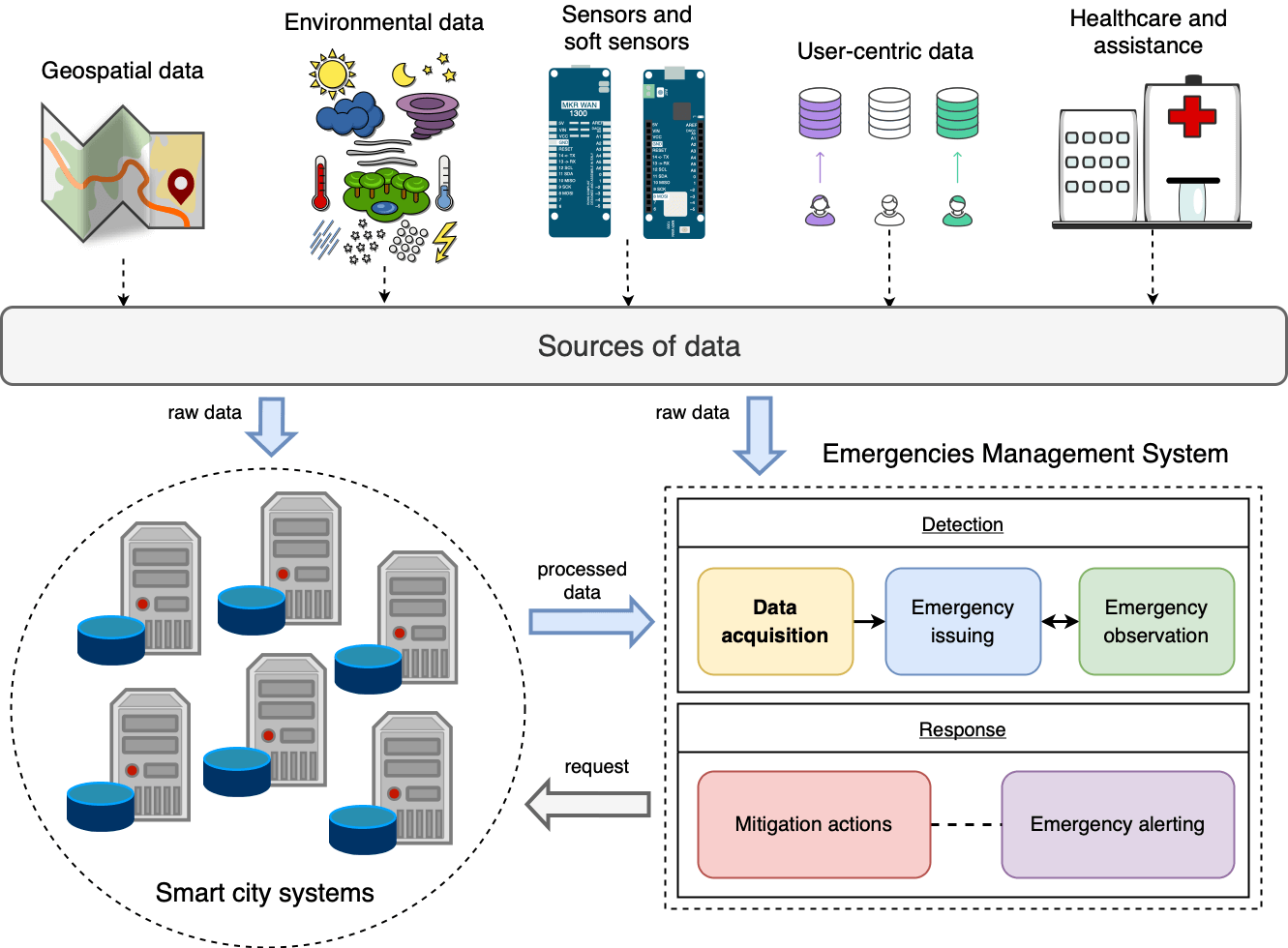Tackling Emergencies Through Multi-System Perspectives of Smart Cities
Written by Daniel G. Costa
Harnessing multiple urban smart systems to create resilient cities has been a primary objective in making smart cities more robust and efficient. Since a smart city can be advocated as a system of systems, many solutions have tried to exploit different types of data to optimize available resources when pursuing higher levels of resilience. However, smart city solutions have been mostly confined to a particular scope of operation with a well-known limited set of parameters, often due to technological constraints and limited availability of relevant data.
This, in turn, demands independent solutions to detect and manage a single type of emergency. In this context, new data-centric solutions exploiting both machine-learning algorithms in the cloud and those on embedded devices have brought new perspectives about complex urban scenarios. Combining these technical solutions with new affordable sensing technologies and crowdsourcing approaches can potentially revolutionize the management of emergencies in a more interconnected way. As a result, it seems natural to expect the emergence of a new generation of practical multi-system solutions to detect, alert, and mitigate different types of complex and even concurrent emergencies, better promoting the construction of resilient cities.
The spatial occupation and population dynamics of cities create a scenario that is inherently vulnerable to the occurrence of emergencies. In short, emergencies may happen anywhere and anytime, with different temporal evolution patterns and potential negative impacts according to a myriad of factors. Historically, cities have tried to adopt mechanisms to alert about emergencies (for example, using bells) and to mitigate them as best as possible (notably fire incidents). The main problem associated with such a traditional approach is that a breakthrough in this process has been only possible with the adoption of modern technologies while keeping legacy systems running. In the last couple of centuries, better urban infrastructure and the consolidation of dedicated response centers such as fire departments have opened a new age for emergency management and disaster avoidance. On the brink of a new age of smart cities, efficient management of urban emergencies is about to enter a new phase.
The Emergencies Management Cycle
Broadly speaking, an emergency situation will be detected such that a set of response actions will take place. Although different formalisms have been adopted when modelling hazards, threats, emergencies, and disasters, with varying nomenclatures and formal definitions depending on the considered problem scope, the main problem that needs to be thoroughly addressed is that detection of an emergency situation is basically the perception that something is wrong and potentially dangerous. With the evolution of data-centric technologies and the spread of potential sources of data, particularly taking advantage of a technological landscape comprising the popularization of the Internet of Things (IoT) paradigm and the affordability of personal gadgets, the possibilities to detect emergencies quickly and more precisely have improved considerably. As a potential result, more efficient acquisition and computational processing of such data have inevitably led to the development of robust emergency-driven response actions, addressing both mitigation and alerting services. When emergencies can be satisfactorily detected, alerted, and mitigated, the emergency management cycle is completed, potentially resulting in safer and more resilient cities.
At this point, the fundamental element of this cycle is the input data. Traditionally, systems dedicated to tacklinge urban emergencies have deployed their own sources of data such as sensor nodes, crowdsourcing algorithms, and data mining routines [1]. However, with the increasing presence of independent smart city systems in operation, new data sources could be exploited, depending on the intended level of integration and adoption of open databases. On the other hand, such systems may also be requested to perform some response actions associated with an emergency, taking advantage of different types of urban automatization. For example, while home automation systems can report abnormal situations that could rapidly spread (external input data), intelligent transportation systems could dynamically respond to an emergency by diverging vehicles from an affected area while automatically dispatching fire trucks and ambulances [2]. This multi-system integration of different urban services tends to be an important pillar for future smart cities.
Integrating Multiple Urban Systems
The first generation of smart cities had been devoted to handle some challenging urban problems such as energy efficiency, traffic management, air quality monitoring, parking, and recycling, among others. Although this scenario is still consolidating, with cities around the world experiencing different levels of “smartness”, a natural trend has evolved as the integration of multiple existing systems to achieve additional goals. In this sense, the area of emergency management would naturally benefit from a more integrated operation of smart city systems, particularly when deciding on algorithms to process a vast amount of data [3]. Actually, with machine learning algorithms exploiting huge amounts of data, while data processing on the edge (TinyML) becomes more affordable, input data from parallel systems could be exploited to enhance emergency-centered services in different levels. As a potential result, multiple data flows such as geospatial mobility data, crowdsourced information, medical data, and social media, among others, could not only needs a support the detection and response of an emergency [4], but also needs to update the continuous perception of how they evolve along the time and affect urban areas (emergency observation). Figure 1 demonstrates such an envisioned scenario.

An emergencies management system within a multi-system smart city.
Although promising, the interconnection of such critical infrastructure systems is not straightforward, and much research effort is still required in this area. Open data formats must be defined and open datasets need to be carefully set to support interconnections. Additionally, interaction interfaces must be established between legacy and new systems if they are expected to interoperate [5]. Finally, development architectures might be designed to facilitate this process. Nevertheless, if properly implemented, the resulting scenario may be very promising when pursuing the construction of safer and more resilient cities [6].
Conclusions
The promotion of smart cities initiatives worldwide has opened a great number of development possibilities to tackle complex urban problems, following different technological paths. The potential result of that is the surge of multiple systems dedicated to handling one or more urban problems, processing data that may be stored or delivered to other systems. In this context, emergency management systems may be constructed exploiting multiple types of available data, eventually resulting in more efficient solutions aimed at reducing the negative impacts of emergencies in cities. Solutions that involve the integration of different technologies such as smart mobility, A&E healthcare, sensing networks, data analytics, and artificial intelligence are all key elements in enhancing emergency management in a smart city.
References
- Lv, Z., Chen, D., & Li, J. (2021). Novel system design and implementation for the smart city vertical market. IEEE Communications Magazine, 59(4), 126-131.
- Fong B, Fong ACM and Li CK, “Internet of Things in Smart Ambulance and Emergency Medicine”, Internet of Things A-Z: Technologies and Applications, Hassan QF Ed., Wiley-IEEE Press, USA, 2018, ISBN: 978-1-119-45673-5
- Costa, Daniel G., Peixoto, Joao Paulo J., Jesus, Thiago, Portugal, Paulo; Vasques, Francisco, Rangel, Elivelton, Peixoto, Maycon. A Survey of Emergencies Management Systems in Smart Cities. IEEE Access, v. 10, 61843-61872, 2022. https://doi.org/10.1109/access.2022.3180033
- Javed, A. R., Shahzad, F., Rehman, S., Zikria, Y. B., Razzak, I., Jalil, Z., Xu, G. Future Smart Cities Requirements, Emerging Technologies, Applications, Challenges, and Future Aspects. Cities, v. 129, 2022. https://doi.org/10.1016/j.cities.2022.103794
- Fong B, Fong ACM and Li CK, “Telemedicine Technologies: Information Technologies for Medicine and Digital Health” 2nd Edition, John Wiley & Sons, UK (2020), ISBN: 1119575745
- Raghavan, S., Simon, B. Y. L., Lee, Y. L., Tan, W. L., & Kee, K. K. Data Integration for Smart Cities: Opportunities and Challenges. Computational Science and Technology, 393-403, 2020.
http://doi.org/10.1007/978-981-15-0058-9_38
This article was edited by Bernard Fong
To view all articles in this issue, please go to August 2022 eNewsletter. For a downloadable copy, please visit the IEEE Smart Cities Resource Center.

To have the eNewsletter delivered monthly to your inbox, join the IEEE Smart Cities Community.
Past Issues
To view archived articles, and issues, which deliver rich insight into the forces shaping the future of the smart cities. Older eNewsletter can be found here. To download full issues, visit the publications section of the IEEE Smart Cities Resource Center.



